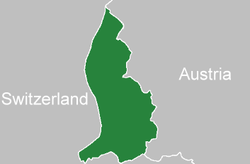Liechtenstein
Liechtenstein (officially the Principality of Liechtenstein) is a country in Western Europe. It is the sixth smallest country in the world[8] and, with Uzbekistan, one of only two doubly landlocked countries. This means that it is bordered only by landlocked countries. Liechtenstein is located between Austria and Switzerland.
Principality of Liechtenstein Fürstentum Liechtenstein | |
|---|---|
| Motto: Für Gott, Fürst und Vaterland For God, Prince and Fatherland | |
| Anthem: (English: "High on the Young Rhine") | |
![Location of Liechtenstein (green) on the European continent (dark grey) — [Legend]](http://upload.wikimedia.org/wikipedia/commons/thumb/3/36/Location_Liechtenstein_Europe.png/250px-Location_Liechtenstein_Europe.png) Location of Liechtenstein (green) on the European continent (dark grey) — [Legend] | |
 Location of Liechtenstein (green) | |
| Capital | Vaduz |
| Largest city | Schaan |
| Official languages | German |
| Demonym(s) | Liechtensteiner |
| Government | Unitary parliamentary democracy and constitutional monarchy |
• Prince | Hans-Adam II |
• Regent | Alois |
| Daniel Risch | |
| Albert Frick | |
| Independence as principality | |
| 1806 | |
• Independence from the German Confederation | 1866 |
| Area | |
• Total | 160 km2 (62 sq mi) (215th) |
• Water (%) | negligible[1] |
| Population | |
• 2010 estimate | 36,010[2] (209th) |
• 2000 census | 33,307[3] |
• Density | 224/km2 (580.2/sq mi) (57th) |
| GDP (PPP) | 2009 estimate |
• Total | $3.409 billion[4][5] (163rd) |
• Per capita | $95,249[4][5][6] (2nd) |
| GDP (nominal) | 2009 estimate |
• Total | $4.797 billion[4][5] (147th) |
• Per capita | $134,045[4][5][6] (2nd) |
| HDI (2010) | very high · 8th |
| Currency | Swiss franc (CHF) |
| Time zone | UTC+1 (CET) |
• Summer (DST) | UTC+2 (CEST) |
| Driving side | right |
| Calling code | +423 |
| ISO 3166 code | LI |
| Internet TLD | .li |
The official language in Liechtenstein is German. The capital of Liechtenstein is Vaduz, a very small town of 5,000 people. Liechtenstein is famous for its many private banks.
Liechtenstein is known as a principality. This means that the monarch has the title of Prince.
History
changeThe territory that is now Liechtenstein was once split into two different states, the County of Vaduz and the Lordship of Schellenberg, which were both part of the Holy Roman Empire.
The Liechtenstein family wanted more power within the Holy Roman Empire. In the 17th century, the Holy Roman Emperor made Karl Liechtenstein a Prince. Karl's descendant, Hans Adam I purchased the lands of the County of Vaduz and the Lordship of Schellenberg and united them into one principality named Liechtenstein.
In 1806, the Holy Roman Empire was broken up by Napoleon. With the fall of the Empire, Liechtenstein became a free independent country. Liechtenstein remained neutral during World War I and World War II. Hitler did have plans to invade Liechtenstein alongside Switzerland in the planned Operation Tannenbaum but never did.
Geography
changeLiechtenstein is located in the European Alps and is bordered to the east by the Austrian state of Vorarlberg, to the south by the canton of Grisons (Switzerland) and to the west by the canton of St. Gallen (Switzerland).
The Rhine forms the entire western border of Liechtenstein. Measured south to north the country is about 24 km (15 mi) long. Its highest point, the Grauspitz, is 2,599 m (8,527 ft).
Despite its Alpine location, prevailing southerly winds make the climate comparatively mild. In winter, the mountain slopes are well suited to winter sports.
Politics
changeLiechtenstein is a constitutional monarchy, meaning that the head of state is a monarch (with the title Prince Regnant) but has limited political powers. The Prince can veto legislations, call for a referendum, create new bills and dissolve parliament.
The legislature is the landtag (or diet). There are 25 elected members. The members of government are usually all members of the biggest political party.
Related pages
changeReferences
change- ↑ Raum, Umwelt und Energie Archived 2011-10-12 at the Wayback Machine, Landesverwaltung Liechtenstein. Accessed on 2 October 2011
- ↑ Bevölkerungsstatistik 30. Juni 2010 Archived 2013-11-14 at the Wayback Machine, Landesverwaltung Liechtenstein. Accessed on 2 October 2011
- ↑ Bevölkerungsstruktur – Band 1 Archived 2013-10-13 at the Wayback Machine, Liechtensteinische Volkszählung 2000, Landesverwaltung Liechtenstein. Accessed on 2 October 2011.
- ↑ 4.0 4.1 4.2 4.3 Key Figures for Liechtenstein Archived 2009-09-17 at the Wayback Machine, Landesverwaltung Liechtenstein. Accessed on 2 October 2011.
- ↑ 5.0 5.1 5.2 5.3 World Development Indicators, World Bank. Accessed on 2 October 2011. Note: "PPP conversion factor, GDP (LCU per international $)" and "Official exchange rate (LCU per US$, period average)" for Switzerland were used.
- ↑ 6.0 6.1 Bevölkerungsstatistik Archived 2013-11-17 at the Wayback Machine. 30 June 2009, Landesverwaltung Liechtenstein. Accessed on 2 October 2011.
- ↑ Human Development Report 2010 (PDF). United Nations. 2010. ISBN 9780230284456. Archived from the original (PDF) on 8 November 2010. Retrieved 4 November 2010.
- ↑ Population by sex, rate of population increase, surface area and density

